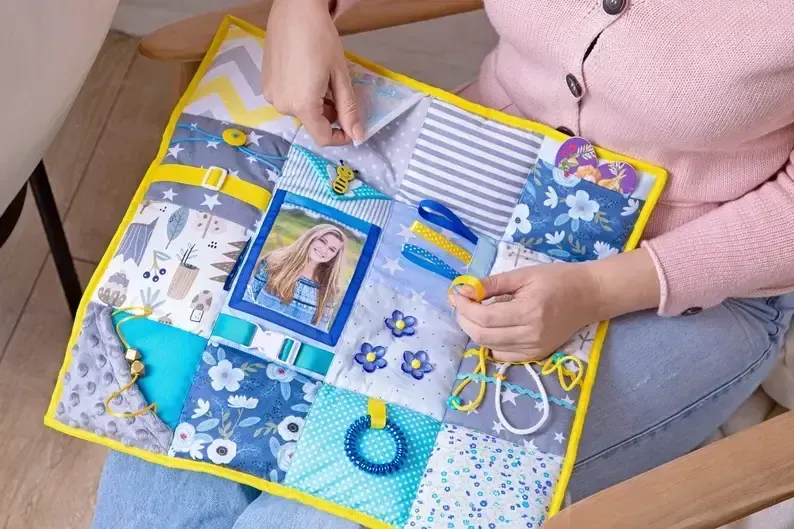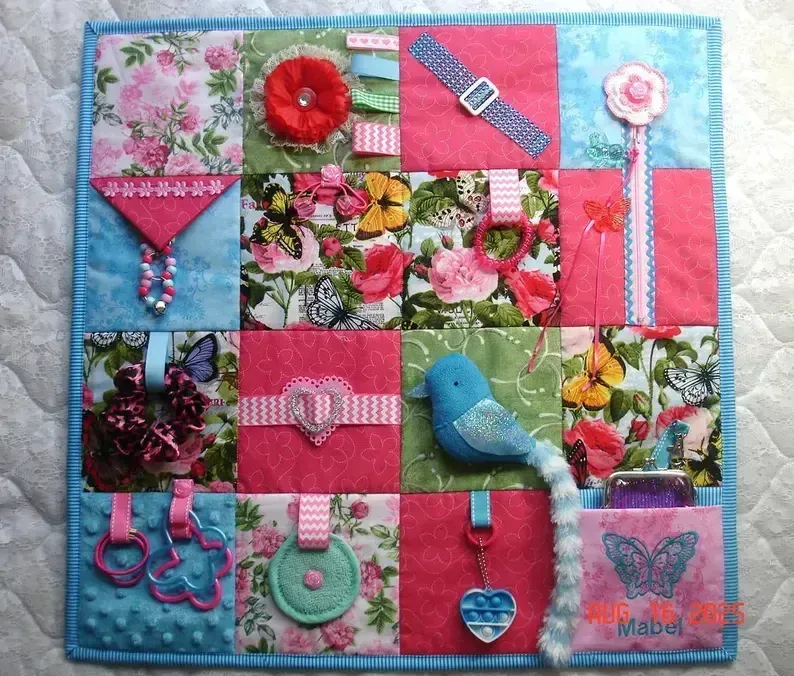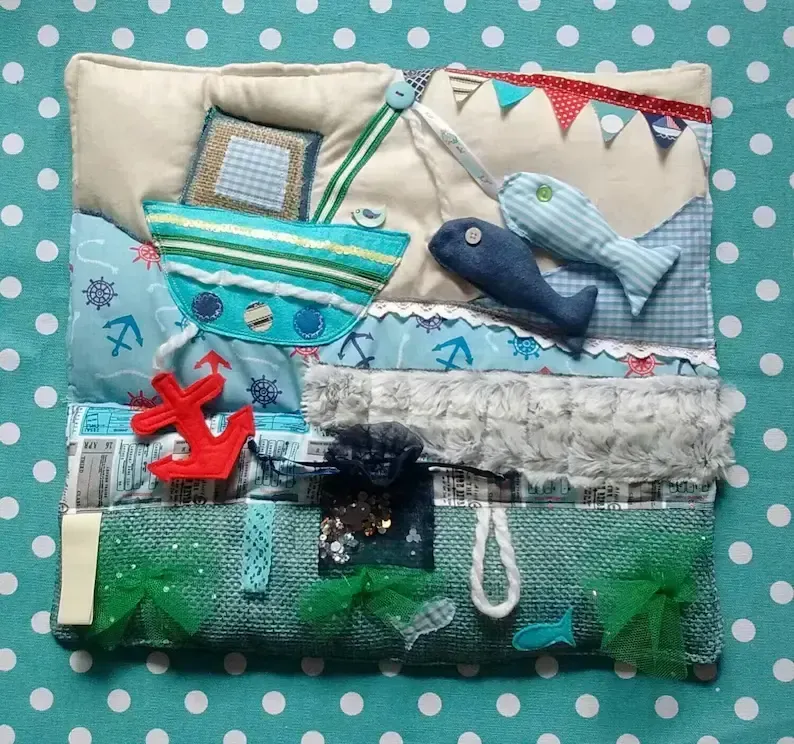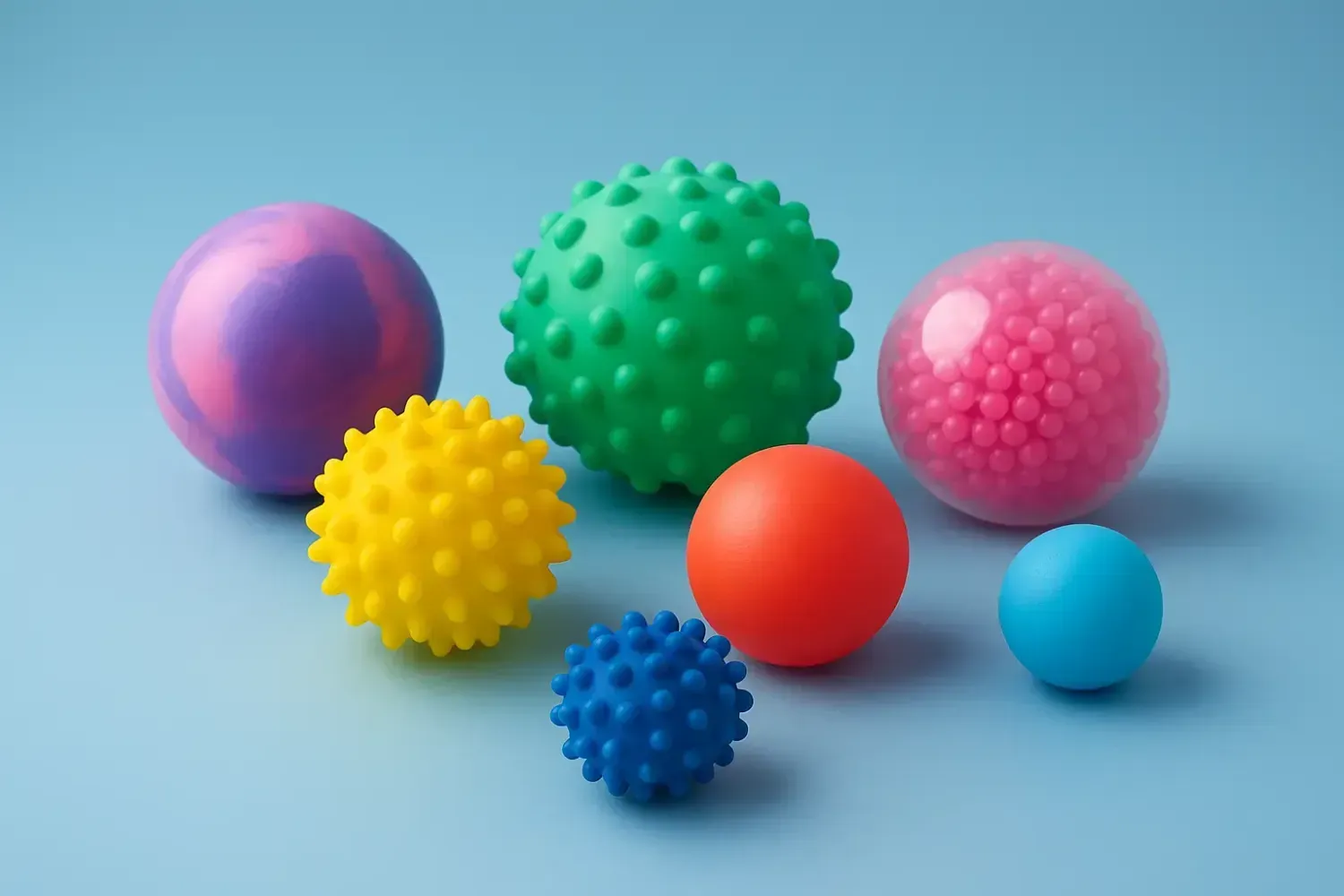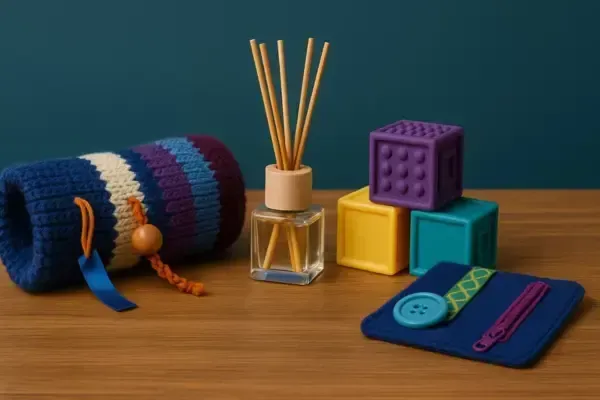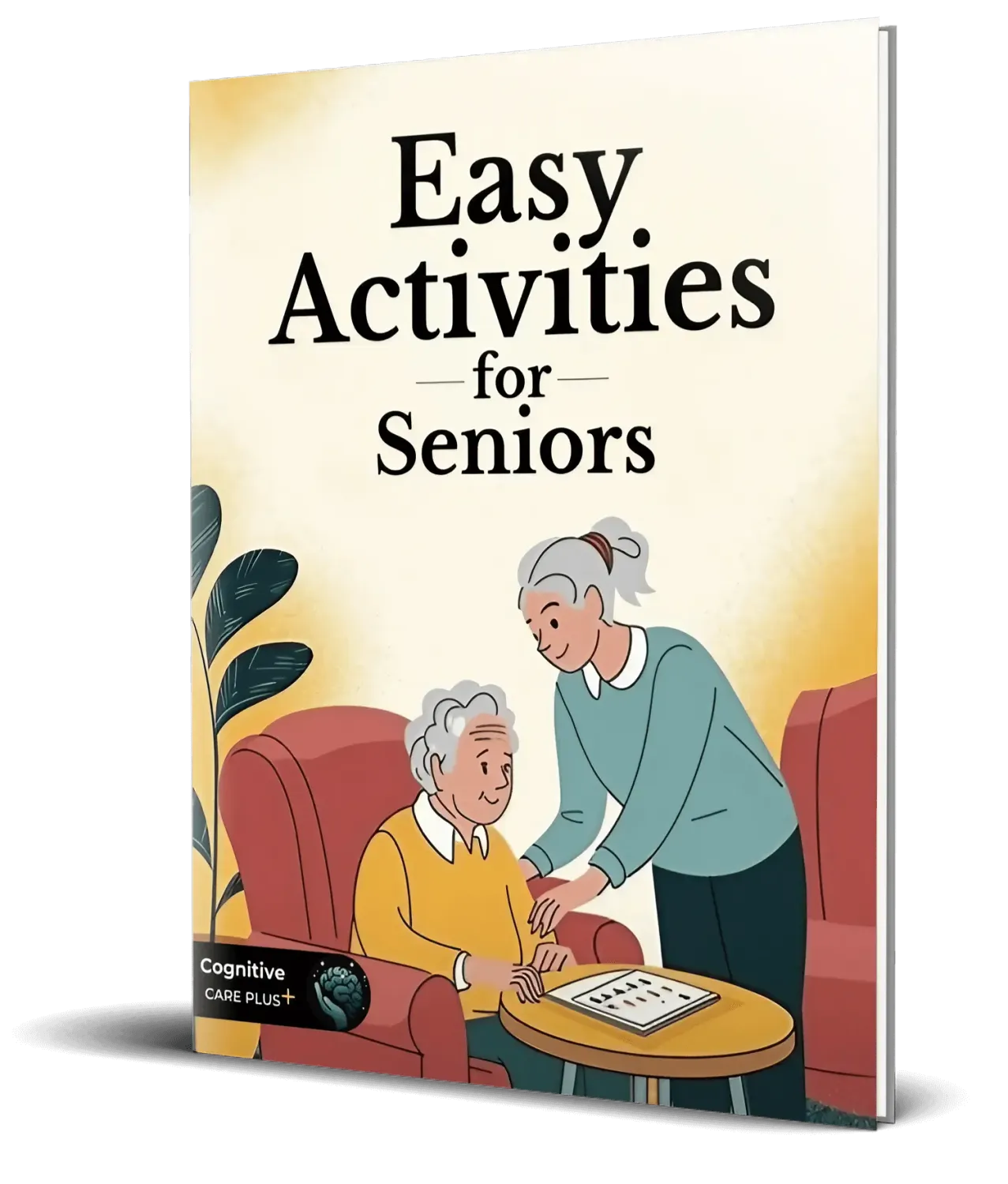Fidget Blankets for Dementia Patients: How They Calm and Engage the Mind
Introduction
I still remember the first time I saw my mom holding a fidget blanket. She had been restless all morning, moving her hands back and forth, pulling at her sleeves. The moment she felt the soft fabric, the buttons, and the zippers, something shifted. Her eyes lit up, her hands found a rhythm, and for a while, she was calm.
If you are caring for a loved one with dementia, you probably know how challenging those restless moments can be. That’s where fidget blankets—sometimes called fidget quilts or activity blankets—become more than just fabric. They are powerful tools that bring comfort, reduce anxiety, and offer meaningful engagement.
🎧 Prefer to listen? Play our podcast episode below to learn how fidget blankets can calm restlessness, boost focus, and bring comfort to adults with dementia—while also supporting caregivers in daily routines.
✨ Enjoyed the episode?
Subscribe to the Cognitive Care Plus Podcast for practical guides, expert insights, and compassionate support to help you care for your loved one with dementia.
What Is a Fidget Blanket?
A fidget blanket is a specially designed lap blanket or quilt filled with textures, objects, and small activities—like buttons, zippers, ribbons, beads, or soft patches.
Think of it as a “sensory playground” for the hands. While it looks simple, for someone with dementia, it’s a safe and engaging way to channel restless energy. Some families call them activity blankets for dementia patients or sensory blankets for adults. No matter the name, the goal is the same: calm the mind by keeping the hands busy.
How Fidget Blankets Help Dementia Patients
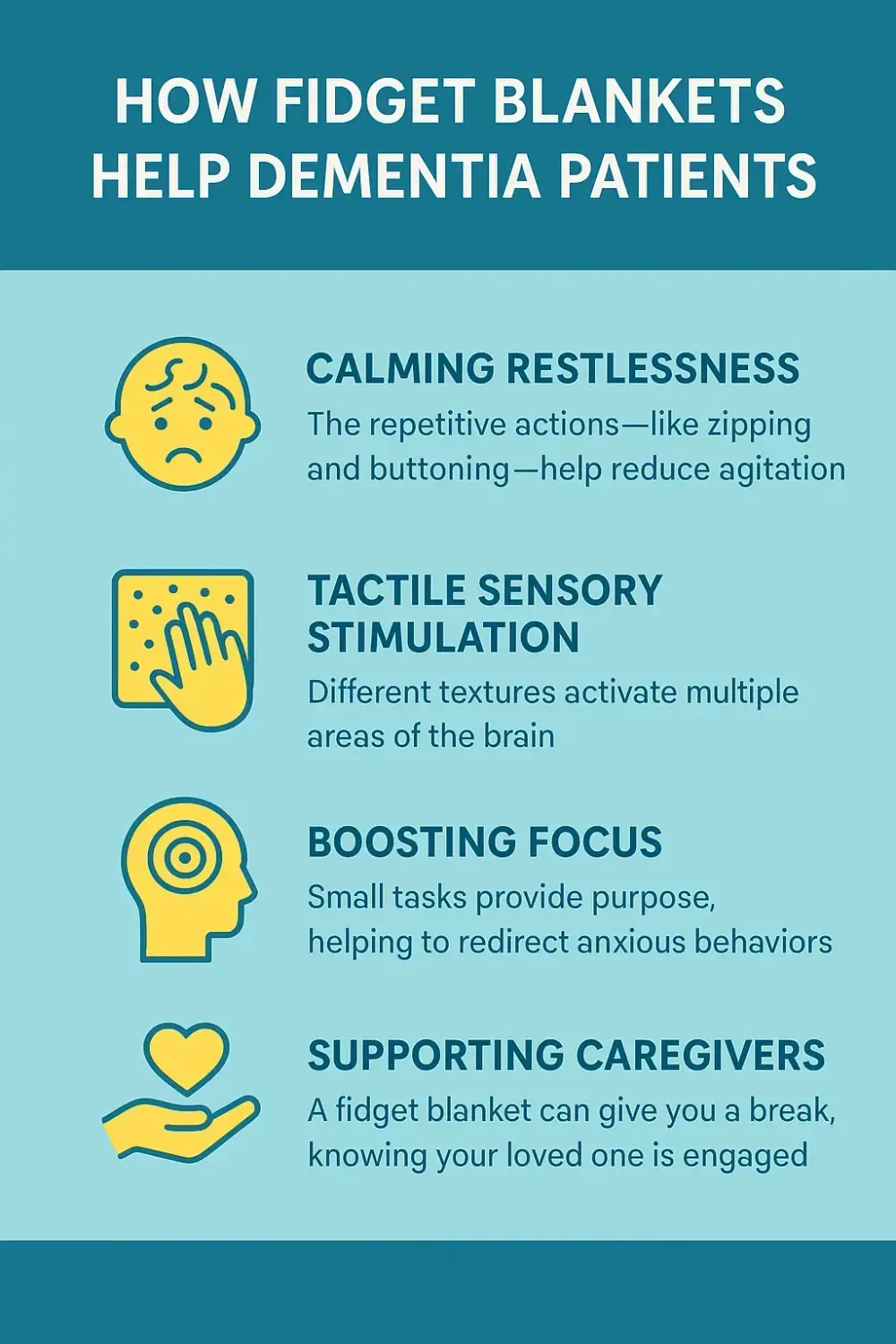
You might wonder: How can a blanket do so much? The answer lies in the way the brain processes touch and movement.
Calming restlessness: The repetitive actions—zipping, buttoning, stroking fabric—help reduce agitation.
Tactile sensory stimulation: Different textures activate multiple areas of the brain, sparking curiosity and comfort.
Boosting focus: Small tasks provide a sense of purpose, helping to redirect anxious behaviors.
Supporting caregivers: A fidget blanket can give you a much-needed break, knowing your loved one is safely engaged.
From a neuropsychological perspective, these activities tap into procedural memory—the kind that often remains strong even in later stages of dementia. It’s like riding a bike: the hands remember what the mind may forget.
One of the most powerful aspects of fidget blankets is their calming effect. As shown in this video, caregivers often work with families to personalize the blankets with colors, textures, or details that reflect the resident’s preferences. This personalization not only makes the blanket more meaningful, it also provides comfort and relaxation. For many individuals living with dementia, engaging their hands with familiar and soothing items can reduce agitation, ease restlessness, and create a sense of peace in moments of anxiety.
Key Benefits of Using Fidget Blankets
Calming Anxiety and Restlessness
Dementia often brings moments of agitation. A dementia fidget blanket acts like an anchor, giving the hands something safe and repetitive to do, which helps the mind settle.
Boosting Sensory Stimulation
A sensory blanket for adults engages touch, sight, and sometimes even sound. Imagine running your hands over velvet, leather, or beads—each texture sends signals that wake up the senses.
Encouraging Independence and Engagement
Even if your loved one struggles with daily tasks, they can still enjoy zipping a pouch or fastening a button. These simple actions promote a sense of accomplishment.
Supporting Memory Care
In memory care programs, activity blankets are often used to keep residents connected, engaged, and calmer throughout the day. They work especially well in quiet rooms or during stressful transitions.
💡 Caregiver Insight
Research from Ohio Northern University (Raabe College of Pharmacy, Ada, Ohio, USA) showed that fidget blankets can calm restlessness and ease daily stress in dementia care. For families, this means fewer difficult moments and more opportunities for comfort and connection.
Looking for the right blanket? Here are three trusted options that bring peace and stimulation to dementia care.
When to Introduce a Fidget Blanket in Dementia Care
One of the most common questions caregivers ask is: “How do I know when it’s time to try a fidget blanket?” The answer depends less on the stage of dementia and more on the daily behaviors you notice.
Signs It Might Be Time for a Fidget Blanket
Restless hands: pulling at clothing, picking at fabrics, or constantly moving fingers.
Anxiety or agitation: pacing, repeating the same movements, or appearing unsettled.
Boredom or lack of focus: looking disengaged, not interested in television or conversation.
Frequent fidgeting with unsafe objects: like tissues, jewelry, or buttons on clothing.
If you see these patterns, an activity blanket for dementia patients can be a safe and soothing alternative.
Matching the Blanket to the Stage of Dementia
Early stage: A fidget blanket may not be necessary yet, but introducing it early can make it feel familiar when it’s needed later.
Middle stage: This is when most caregivers find dementia fidget blankets especially useful. They help channel restlessness and encourage focus during long days.
Late stage: Even if verbal communication is limited, the sense of touch remains powerful. A soft Alzheimer’s activity blanket can provide comfort and reduce anxiety.
For a clearer picture of how needs change over time, take a look at our 🧠 Dementia Stages Chart. It can help you understand when a fidget blanket—or other sensory tools—might be most supportive for your loved one.
Why Timing Matters
Introducing a fidget blanket for dementia too late may lead to rejection, as your loved one might not recognize or accept it. Starting earlier, when they’re still open to new routines, helps the blanket become part of daily comfort.
Think of it as adding a new friend into their care journey—a friend that keeps the hands busy, calms the nerves, and brings peace to the mind.
Fidget Blankets vs. Other Sensory Tools
How do fidget blankets compare to other options like fidget toys for adults, stuffed animals, or busy boards?
Fidget toys are portable but can get lost easily.
Busy boards are larger and need to stay in one place.
Therapy animals bring comfort but don’t offer as much fine motor stimulation.
The blanket sits in between: portable, safe, and versatile. Plus, it’s cozy—your loved one can literally wrap comfort around their lap.
How to Choose the Best Fidget Blanket for Your Loved One
When shopping for a fidget blanket for dementia, keep these factors in mind:
Size & Weight: A lap-sized blanket works best—large enough to cover but light enough to move easily.
Textures & Activities: Look for variety—soft patches, zippers, buttons, Velcro. This ensures ongoing engagement.
Safety Features: Avoid sharp objects or detachable pieces that could become choking hazards.
Personalization: Some caregivers even create DIY fidget blankets, adding family photos or fabrics with sentimental value.
Whether you search for a fidget blanket for elderly or an activity blanket for dementia patients, the right choice depends on your loved one’s needs and personality.
FAQ
What is a dementia blanket?
A dementia blanket, also called a fidget blanket or sensory blanket, is a soft fabric with textures, zippers, buttons, ribbons, or pockets. It gives the hands something to do, helping reduce anxiety, restlessness, and agitation. These blankets also provide gentle mental stimulation, keeping the mind engaged in a safe and comforting way.
Are fidget blankets good for dementia patients?
Yes. Research and caregiver experiences show that fidget blankets help reduce anxiety, calm restlessness, and keep hands safely occupied. They are especially useful in care homes and at home for providing comfort without medication.
What makes a good fidget blanket?
A good fidget blanket should be soft, safe, and washable. It needs to include easy-to-use elements like zippers, large buttons, or ribbons, but without small pieces that could detach. The best ones balance calming textures with stimulating activities, giving the user both comfort and gentle engagement.
What is the difference between a fidget quilt and a fidget blanket?
There is no real difference—both terms refer to the same item. Some people call them fidget quilts because of their patchwork design, while others say fidget blankets. In both cases, the purpose is identical: to calm and engage the mind.
Can fidget blankets help with Alzheimer’s disease?
Yes. Many families use Alzheimer’s activity blankets as part of daily care, especially during the middle and late stages of the disease. They provide comfort, reduce agitation, and help loved ones stay meaningfully engaged.
Other Activities for Seniors in Memory Care
While fidget blankets are wonderful, they’re not the only option. Other engaging activities include:
Simple puzzles or memory games
Gentle crafts like sorting or folding
Group activities in care homes (activities for seniors such as bingo or singing)
Home activities for dementia patients like gardening or cooking together
Pairing a fidget blanket with other activities creates a balanced routine that stimulates both mind and heart.
Conclusion
A fidget blanket is more than fabric. It’s comfort, engagement, and calm stitched together. For my mom, it wasn’t just something to do with her hands—it was a doorway back to peace, even if only for a while.
If you’re looking for a gentle, effective way to support your loved one, consider adding a fidget blanket to your caregiving toolkit.
Because every touch can bring a moment of calm—and every moment matters.
👉 Looking for more engaging ideas for seniors? Explore all our categories to find activities, sensory tools, and brain-boosting resources for every stage of dementia care.
Share this article:
If this article helped you, share it with other caregivers who need encouragement.
Join Our Caring Community 💙
Subscribe to receive practical tips, helpful resources, and engaging activities for supporting loved ones with memory challenges. Stay informed, stay empowered!
You may also be interested in
Related articles
💬 We’d love to hear from you!
Have you tried using a fidget blanket as part of your loved one’s daily routine with dementia? What activities or textures have brought them comfort or joy, and what challenges did you notice? Share your experiences and tips in the comments below—your story could inspire and support another caregiver on this journey.

Trending
Simple tools that make caregiving...
Turning simple play into a brain-boosting activity...
Here’s what to look for when choosing...

About me

Hi there 👋 My name is George Cassou, I'm a psychologist and the creator of this blog. Inspired by my journey caring for my mom with Alzheimer's, I share activities and tips to bring joy and connection.

Affiliate Disclosure:
This website contains affiliate links. If you click on these links and make a purchase, we may earn a small commission at no additional cost to you. These commissions help us keep this site running and allow us to continue creating helpful content to support caregivers and families.
